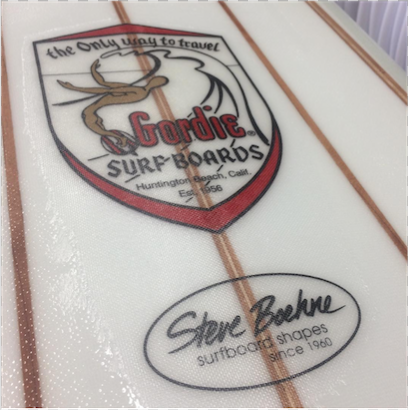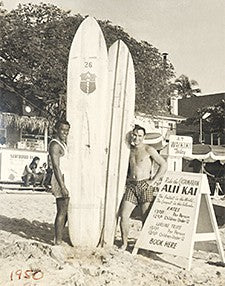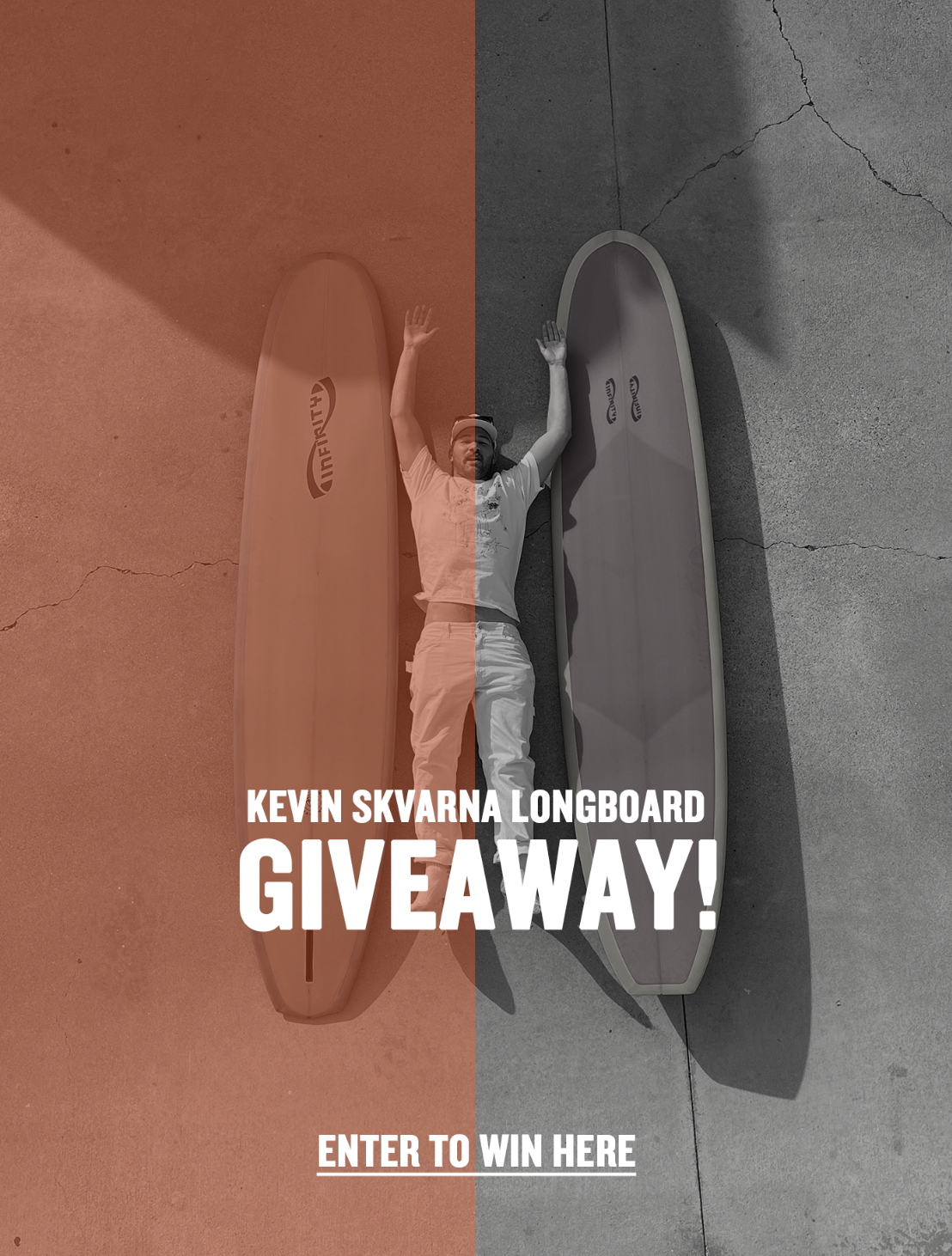Shaping For Gordie

(Originally written by Steve in 2007. Gordie passed away in 2011)
I first saw Gordie boards in 1964 when I would take blanks I had shaped into Jack Pollard’s glass shop in Hermosa Beach. The Gordie’s always stood out amongst the other name brand boards because of the extra stringers, woodwork and tail blocks he would do. I had been a garage shaper for about 8 years when I moved to Huntington Beach in 1968 and started taking my blanks into Bill Holden’s glass shop. Bill thought I was doing a pretty good job so he said: “Why don’t you go down and see Gordie about a shaping job”. He knew that Gordie needed a shaper at the time, so he called Gordie and put in a good word for me. I went into the Gordie shop the next day and introduced myself. Gordie was busy shaping a board. He said why don’t you stick around a while and watch how I do things. Gordie worked fairly slow and methodical, sanding and rechecking everything 4 times. I thought to myself; man this guy is really a perfectionist. While he worked, a constant flow of crusty old surf friends and younger hard core guys flowed through to say hi. When he was done Gordie said: “What was your name again?” I said Boehne. He said, “That sounds like Bo Diddly Weenie; come in tomorrow and shape a board”. I was so happy about the chance to actually work in a surf shop that I didn’t even care about him screwing up my name.

The Gordie shop on 13th St. In Huntington Beach was situated on a giant lot facing Pacific Coast Hwy. In the back yard, out behind the shop, Gordie had a horse corralled and a big cage with an owl in it. Next to the owl cage was a small auxiliary shaping room with a tiny bathroom exhaust fan. The only light was a bare 150-watt bulb situated directly above the shaping rack. Sidelights used by shapers these days had not been thought of yet. You sanded the board up on edge to see the shadows created by the single light bulb. I realized years later that this “top” light was one of the secrets to shaping Gordie’s famous egg rails because you have a constant full view of the rail while you are sanding. Shapers nowadays sand with the blank flat on the rack so they can’t see the edge of the rail and the deck at the same time.


There was a second copy of his templates hanging on the wall. He said: Here’s a blank, do a 9’6” nose rider, use this template. I had already seen what a perfectionist he was so the pressure was on. I spent the entire day, about seven hours on that one board. It was the best job I had ever done on a board. When I was finished, I called Gordie in to check it out. He was way cool, He lifted up the nose with the side of his index finger the way shapers do so they won’t dent the foam. He looked down both rails and said: “Watch me fix it up”. I was amazed while I watched for the next hour as Gordie transformed my Neanderthal whittling into a finely sanded surfboard. I thought for sure that he would say: Well Bo Diddly, you better pack your things and go. Instead he said: “come on back tomorrow and we’ll do another one”. I will always thank Gordie for painstakingly showing me all the techniques to shape a finely tuned surfboard. He has had a tremendous influence over the basic look of my surfboards to this day. Every Infinity board has quite a few Gordie genes. In fact all the many guys who I have taught to shape are carrying on those Gordie genes. Come to think of it, we are right in line behind Gordie, Able Gomes and The Duke himself.

(taken from the old Gordie website):
“There was a SHAPERS TREE published in Surfing magazine around 1980 that showed the infant origins of our surfboard industry’s shapers up to that point in time. I acknowledge that there were decades of unknown Hawaiian shapers in the early prehistory of our sport, but in the known times since 1900 surfing started in Waikiki with the official ambassador, Duke Kahanamoku. Amongst Duke’s peers there was a great waterman and surfboard shaper named Able Gomes who taught Gordie how to shape his first board.

Gordon Duane, Gordie is very proud that his name appears in the shapers tree in the third tier right below Duke Kahanamoku’s. The second tier just above Gordie is made up of the first surfboard shapers of the 1930’s and 40’s including Californians; Pete Peterson, Tom Blake, Joe Quigg, Lorrin Harrison, Dale Velzy and Bob Simmons. All these guys were introduced to shaping by the Hawaiians in Hawaii. The third tier were guys who started shaping in the 1950’s. They included (amongst others) Gordon Duane, Renny Yater, Hobie Alter, Hap Jacobs, Johnny Rice and Greg Noll. As the tree grows downward in the fourth tier there are many names including guys who Gordie taught to shape starting with: Mike O’day, Larry Felker, Del Cannon, Don Stuart, Bruce Jones, Steve Boehne, Jim Fuller and Randy Lewis.”
Gordie hated boards with thick “club” noses and “ears” as he called them. He wanted the high point in each rail to join together exactly at the tip of the nose. He liked the thickness of the board to taper all the way to the tips and not look like the blank had been sawed off then just rounded off. His rails were unique. You couldn’t tell where the deck or bottom of the board ended and the rail started, they just flowed together. The rail is an increasing parabolic curve that forms a perfect egg. The stringers had to be planed down perfectly smooth so that if you closed your eyes, you couldn’t find the stringer by touch.

Gordie was always courteous, even fatherly to me in the shaping room, but out in the shop, he was an intense, in your face kind of guy. People gravitated to him partly because of his boards, and partly because of his intense personality. You always felt relief when Gordie agreed with what ever you had to say. If he didn’t like you or your opinion, he’d tell you right to your face. If he didn’t like a particular customer, or even if he did like’m but was too busy to bull shit, he’d just run them out of the shop. There was a movie that came out in the early 1970’s called Deliverance. It featured a Hillbilly guitar and banjo duet called the Dueling Banjos. The star actor in that movie was a young Burt Reynolds; his character was a very tough customer. If you ever wanted to know what Gordie was like, just rent that great movie. Gordie was a handsome tough customer just like that character.

For me, shaping at the Gordie shop was a great learning experience and it was also like living in a who’s who book of surfing personalities. Every afternoon about 4:30 a motley assortment of crusty old surfers, shapers, glassers, bikers, hot roders and old friends would stop by the shop for a visit. The beer would flow, but the stories would flow even more. Velzy was a regular, but there was sometimes a visiting Hawaiian from the old Waikiki days or guys from the original Gordie shop under the pier days. There weren’t any chairs in the shop, everyone would just sit on the grass mat on the floor, lean against the wall and suck on a beer. Any customer who would wonder in could either sit on the floor and have a beer or leave, they just couldn’t buy anything.

Up to 1967, surfboards had steadily been getting longer, mostly in the 9’6” to 10’6” range. There were specialty shapes: speed boards like the Phil Edwards model, Gordie Mark 5 and nose riders like the Gordie Lizard (a “step deck”) and Gordie Nose Rider with a concave under the nose. 1968 was the beginning of the short board revolution. The Aussies had introduced the “short” V- bottom boards with super wide square tails. Gordie designed a much sleeker looking, pintail V-bottom that he called the Assassin. Gordie named it the Assassin because the surfer could assassinate the wave with this powerful surf weapon. It was an exciting time, the baby boomers were learning to surf and they wanted the new, hot short board designs. Gordie found that his old clientele still wanted his stylish long boards and since I was a baby boomer, I was really into the short board thing. I ended up shaping almost all of the Assassins made in 1968 and 1969. In 1970, I moved on to shape for three other shops in Huntington Beach as well as start my Infinity Surfboard brand.

Gordie had a crazy numbering system. Most shops number all of their boards consecutively, but Gordie got started numbering each board according to which dealer had ordered it. What was really unique was the lists of all the boards were written on his shaping room walls. The lists were spread out as high as you could reach, in every available space around the room. First there was his shop list and then each dealer list. We had to sweep the foam dust off the walls every so often just to find the next number to use. In 2004 before the shop was demolished, Gordie got a pad and pen, added up all the lists and found that he had made around 46,000 surfboards since the beginning. That is why you may notice that all the Gordie boards that I am now shaping are numbered starting at 46,000.

In 1968 when I worked for Gordie, I was 21 years old and he was 38. Of course he seemed much older to me because he was nearly twice my age and he was from the “old pre historical” balsa wood days. His shop was sold out from under him in 2004 and he had a stroke a couple of years ago, so his shaping days are over. I realized that the tradition must live on, especially in 2005, his shop’s golden anniversary. I contacted John Van Oeffelen, Gordie’s longtime friend and team rider about building Gordie boards. They brought Gordie’s old mahogany full-length templates down to the Infinity shop and I got started.
Shaping surfboards is like being a musician, you may not be the original artist, but you can play the same songs, use the same instruments, copy the intonations and sound almost the same. I could use the same old templates, use the same techniques, duplicate that wonderful rail and produce a damn nice Gordie surfboard. Using the old templates was like hearing an old favorite song again after a long time away. I could almost hear the old music playing on the radio in the auxiliary shaping room when I used to shape there in 1968: Classical Gas, Me and Bobby McGee, The Beatles, Simon and Garfunkle. The old templates were worn smooth from tracing thousands of outlines. They seemed to vibrate an intended use at “Gordieland, Makaha, Pipe Line, Trestles and HB Pier. They are still beautiful, flowing curves.
I finished four Gordie boards. When they came back from the glass shop, I called Gordie and said: “Come on down and check the boards out”. The next day John and Gordie showed up. Gordie walked slowly up to the boards in the rack and scrutinized the outlines; they passed inspection. He was impressed with the stringer selection (I think). Then he laid those maestro time weathered hands on the rails, closed his eyes and caressed them gently like feeling a young, firm breast. Maybe that’s why they always said Gordie’s rails are sexy). He compared them to the thousands that he has shaped. He said: “Boehne, these rails are a little fat, tuck’m in a little right here”. I said; “sure Gordie”. The next ones were perfect.
When they left, I had to laugh, I am nearly 59 years old (in 2006) twenty years older than he was when I worked for him, I’ve shaped around 20,000 surfboards since then and I’m still trying to get it right for Gordie!
I made Gordie surfboards and sold them in my shop for several more years until he died in 2011.

